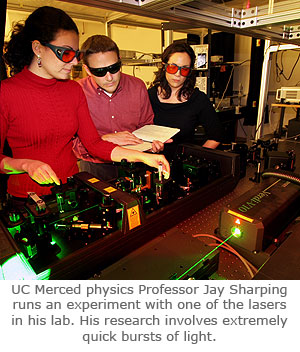

It’s supersmall, ultracold and hyperfast. It’s the extreme science carried out in some of UC Merced’s labs.
Researchers in the
School of Natural Sciencesare pushing boundaries in hopes of yielding results that could change the world. One professor works with artificial atoms, another one uses pulsing lasers and one more studies nanostructures. Their
research- in photons, artificial atoms and molecules - is only a sampling of UC Merced’s cutting-edge interdisciplinary research that could impact renewable energy, health and communication.
Physics Professor
Sayantani Ghoshstudies how artificial atoms, known as quantum dots, react to light and temperature because the rules of physics change at the quantum scale. For example, a ball thrown against a wall will always bounce back. An atom or electron shot at the wall has a chance to go through it, she explained.
In some experiments, the researchers take the dots down negative 452.47 degrees Fahrenheit, to see how they behave. Each dot is one to 10 nanometers in diameter. A nanometer is a billionth of a meter.
The motivation to investigate quantum structures lies in the rapid miniaturization of technology. Blue Ray discs now hold twice as much as ordinary DVDs and smaller iPods can hold more songs than ever before. But this won’t go on forever, Ghosh said.
“At some point we will reach atomic length scales and quantum mechanics will dominate, making classical techniques inapplicable.”
Ghosh is working with Shrink Nanotechnologies to apply quantum dots in solar energy storage devices, which will replace traditional silicon-based designs. This new technology has the potential to be more user-friendly and less expensive, making it more reasonable for people to install solar panels in their homes or businesses.
Downstairs, physics Professor
Jay Sharpinguses lasers that pulse at intervals of 50 femtoseconds, far faster than what’s visible to the human eye. One femtosecond is one quadrillionth of a second.
“Working with light is exciting because the experiment happens very quickly,” Sharping noted. “You can do the experiment thousands and thousands of times.”
The rapid pulses can capture extremely swift changes, such as when chemicals are combined. The technology allows scientists to better study tissue and cells below the skin with better depth and resolution.
Sharping is collaborating with engineering Professor
Ariel L. Escobar, who wants to use the lasers to study the heart muscle.
Besides health impacts, the lasers can also generate pairs of photons which, when used with computer encryption, can create ultra-safe communication channels for high levels of government.
Chemistry Professor
Tao Yestudies the ways artificial molecular machines can be used to perform many interesting tasks, such as combating devastating diseases like cancer. Molecules moving around the body like tiny robots are what make a person’s arms swing and retinas dilate. One of the goals is to create artificial molecules - or nanostructures - that can be dispatched to deliver medicine and attack disease cells. Right now, scientists need to understand how they react and behave to develop strategies to control them.
“You can’t force a molecule into place. They have a lot of energy and move faster than a car on highway,” he said. “You have to coax them into the right place.”
Ye uses an atomic-force microscope to image and manipulate individual molecules, which are so tiny that billions of them can fit on a pinhead. The microscope has a minuscule needle that is slowly drawn across molecules. The results are converted into an image.
There are some ongoing clinical trials for using nanostructures in medicine, though through the work of Ye and other researchers, it’s expected there’ll be more treatments in the coming years.






